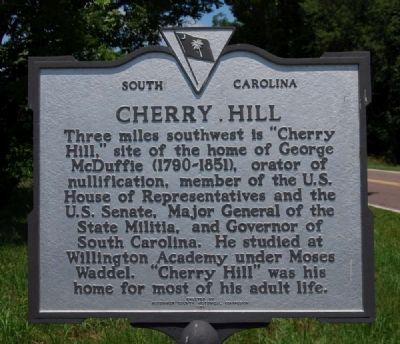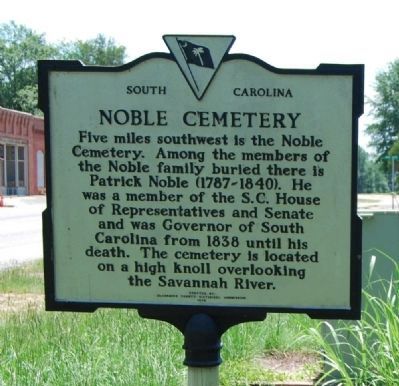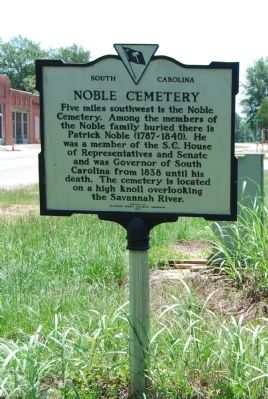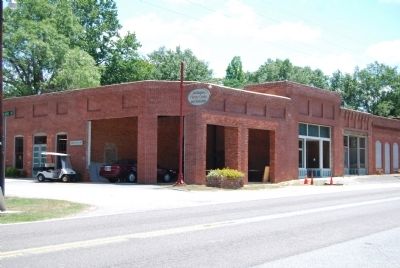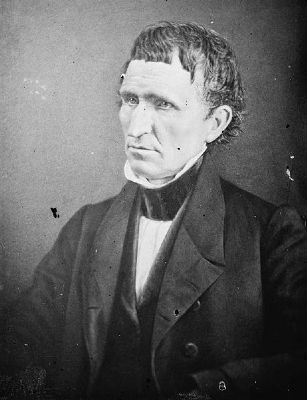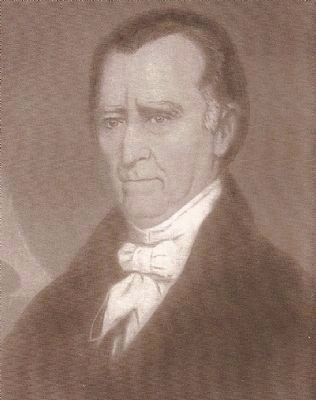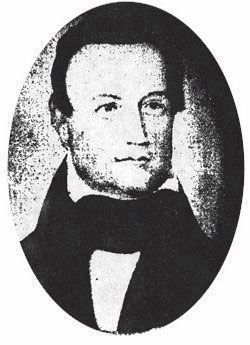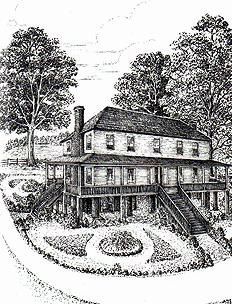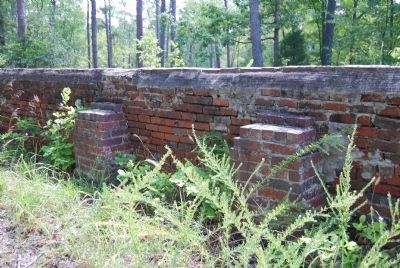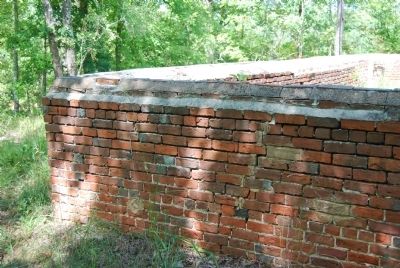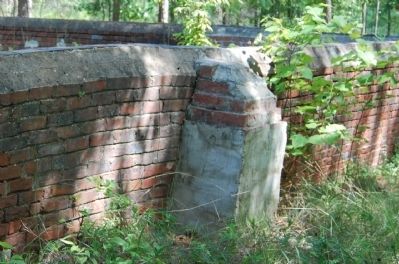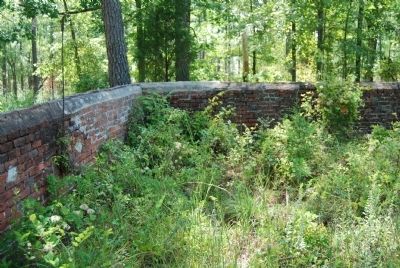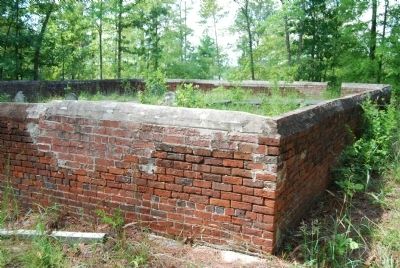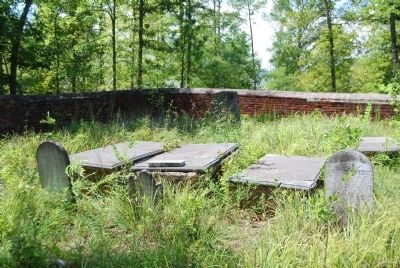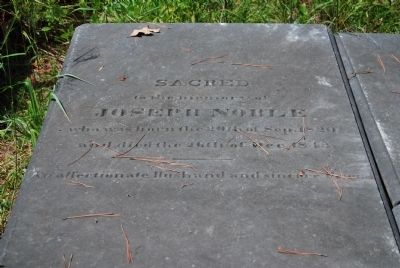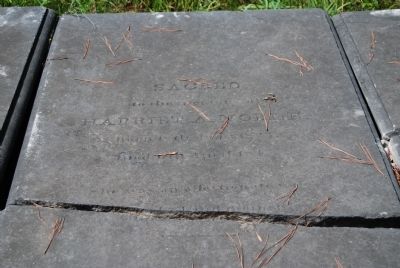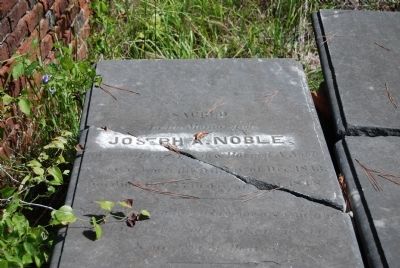Willington in McCormick County, South Carolina — The American South (South Atlantic)
Cherry Hill / Noble Cemetery
Erected 1974 by McCormick County Historical Commission. (Marker Number 33-11.)
Topics and series. This historical marker is listed in this topic list: Cemeteries & Burial Sites. In addition, it is included in the South Carolina, McCormick County Historical Commission series list. A significant historical year for this entry is 1838.
Location. 33° 58.301′ N, 82° 28.035′ W. Marker is in Willington, South Carolina, in McCormick County. Marker is at the intersection of State Highway 81 and Morrah Bridge Road (County Route 39), on the left when traveling north on State Highway 81. Touch for map. Marker is in this post office area: Mount Carmel SC 29840, United States of America. Touch for directions.
Other nearby markers. At least 10 other markers are within 3 miles of this marker, measured as the crow flies. Willington Academy (here, next to this marker); Willington (within shouting distance of this marker); Site of Willington Presbyterian Church (approx. 1.1 miles away); Site of Willington Academy (approx. 1.2 miles away); Guillebeau Home and Family Cemetery (approx. 2 miles away); Andre Guillebeau (approx. 2.3 miles away); John De La Howe School Enterprise Market Program at "The Barn" (approx. 2.7 miles away); John De La Howe School (approx. 2.7 miles away); John De La Howe / John De La Howe School (approx. 2.8 miles away); De La Howe Hall (approx. 3 miles away). Touch for a list and map of all markers in Willington.
Also see . . .
1. George McDuffie. George McDuffie (August 10, 1790 – March 11, 1851) was a Governor of South Carolina and a member of the United States Senate. (Submitted on November 27, 2009, by Brian Scott of Anderson, South Carolina.)
2. Nullification. Nullification is a legal theory that a U.S. State has the right to nullify, or invalidate, any federal law which that state has deemed unconstitutional. (Submitted on December 11, 2009, by Brian Scott of Anderson, South Carolina.)
3. Cherry Hill Plantation – – McCormick County. Location – One mile from Willington Academy, McCormick County. (Submitted on November 27, 2009, by Brian Scott of Anderson, South Carolina.)
4. Patrick Noble. Patrick Noble (1787 – April 7, 1840) was an antebellum Democratic Governor of South Carolina from 1838 until his death in 1840. (Submitted on November 27, 2009, by Brian Scott of Anderson, South Carolina.)
5. Patrick Noble, 1838-1840. Born: 1787 near Willington, Abbeville District, South Carolina. (Submitted on July 20, 2008, by Brian Scott of Anderson, South Carolina.)
6. Noble Cemetery Index. Most of the information about this cemetery was copied with permission from McCormick County Cemeteries prepared by the McCormick County Historical Society in 1987, whose members are deeply thanked. (Submitted on September 14, 2008, by Brian Scott of Anderson, South Carolina.)
Additional commentary.
1. Cherry Hill
In the same year McDuffie returned to Willington, he bought a plantation known as "Cherry Hill" only a mile from Willington Academy. Previously owned by Ezekiel Noble, the beautiful home had burned. McDuffie rescued the run down plantation. He built a sprawling two-story home with elaborate verandas that provided a panoramic view from the high home site. Cherry Hill would be home for McDuffie for the rest of his life. The north side of the hill descended precipitously. Down the valley to the west flowed the majestic Savannah River. An avenue of trees led up to the plantation house, around which grew shrubs and trees of the rarest. McDuffie increased the size of the plantation to contain over 5,000 acres with 175 slaves. Cherry Hill was the admiration of the locality. McDuffie entertained with much hospitality the many friends and colleagues who visited.
Cherry Hill was a model plantation. In a letter to friend, McDuffie wrote that it contained 750 acres of cotton, 325 in corn, 100 in wheat, 300 in oats, 10 in peas, potatoes, etc. He made good crops. On the plantation was raised wool, which was spun and woven into clothes for the slaves. A cotton warp thread was manufactured into "liney," a cloth used for slaves' clothing, also. (Source: The Making of McCormick County by Robert Edmonds (1999), pgs 185-186.)
— Submitted November 28, 2009, by Brian Scott of Anderson, South Carolina.
2. George McDuffie (1790 - 1851)
George McDuffie, (father-in-law of Wade Hampton [1818-1902]), a Representative and a Senator from South Carolina; born in Columbia County, Ga., August 10, 1790; attended an old-field school and a private academy; graduated from South Carolina College
(now the University of South Carolina) at Columbia in 1813; studied law; admitted to the bar in 1814 and commenced practice in Pendleton, Anderson County, S.C.; member, State house of representatives 1818-1819; elected to the Seventeenth and to the six succeeding Congresses and served from March 4, 1821, until his resignation in 1834; chairman, Committee on Ways and Means (Nineteenth through Twenty-second Congresses); one of the managers appointed by the House of Representatives in 1830 to conduct the impeachment proceedings against James H. Peck; Governor of South Carolina 1834-1836; president of the board of trustees of South Carolina College; elected as a Democrat to the United States Senate to fill the vacancy caused by the resignation of William C. Preston; reelected, and served from December 23, 1842, until August 17, 1846, when he resigned; chairman, Committee on Foreign Relations (Twenty-ninth Congress); died at ‘Cherry Hill,’ Sumter District (now Sumter County), S.C., March 11, 1851; interment in Cherry Hill Cemetery, Sumter District, S.C. (Source: Biographical Directory of the U.S. Congress.)
— Submitted November 27, 2009, by Brian Scott of Anderson, South Carolina.
3. Moses Waddel and the Willington Academy in South Carolina
One morning in the late autumn of the year
1794, a Presbyterian preacher left the Georgia side of the Savannah River and crossed over to South Carolina. He was of low stature and had a boyish face, for he was only twenty-four years of age. He rode to a schoolhouse that stood in the Calhoun Settlement, on Long Cane Creek, in Abbeville District, and found assembled there a company of Scotch-Irish people. When he arose to speak, the congregation was surprised to hear a deep-toned, musical voice. The preacher's calm, gray eyes looked straight into their eyes and his earnest, rapid talking caught their attention. When the sermon was ended, Patrick Calhoun, patriarch of the community and elder in the neighboring church, led the minister to his home. While they were seated, that evening, around the wide, old-fashioned fire-place in the Calhoun home, the door was opened and a youthful face looked in, but was at once withdrawn. The face belonged to John Caldwell Calhoun, Patrick Calhoun's son, who afterwards became South Carolina's great statesman. A year later, the young minister, whose name was Moses Waddel, married Catharine Calhoun, sister of John C. Calhoun, and took her to his home beyond the Savannah. There, in Georgia, Waddel was preaching the gospel and teaching Latin and Greek to a group of schoolboys.
Moses Waddel was born (1770) in Iredell County, North Carolina. His parents were Scots from North Ireland. Soon
after Moses completed his eighth year he went to James Hall's school and began to study Latin. After six years of work, he finished the courses of study in Greek, Latin and mathematics, as far as these subjects were taught in the school. Then he took charge of various schools in North Carolina and Georgia until the year 1789, when he gave his heart to Christ. After a long struggle within his own breast, young Waddel determined to become a preacher. In the autumn of 1790, therefore, he mounted his horse and made the long journey from Georgia to Virginia. In the month of September in that year he began a course of study at Hampden Sidney College. A little more than a year later he left the college, and in May, 1792, was licensed by Hanover Presbytery to preach the gospel. The year 1794 found him established as pastor of Carmel Church, south of the Savannah. At the same time he organized a school in Columbia County, Georgia. Near the close of that year he crossed the Savannah, as we have seen, and there met Catharine Calhoun, who became his wife and his helper in the Georgia school. In 1801 Waddel moved his home to Abbeville District, South Carolina, and there opened his school in the village of Vienna. A little later, however, he selected a site upon a ridge near the Calhoun Settlement. There, among oak and hickory trees, he erected a log house and called it Willington Academy. Log
cabins for the students were put up near the main building. For a long period of time, as many as one hundred and eighty students came each year to receive instruction from this wonderful teacher, Moses Waddel.
The food furnished to the students in Waddel's log college was plain, for it was usually nothing more than cornbread and bacon. A blast from a ram's horn called them all together for morning and evening prayers. When the weather was mild the students sat or lay beneath the trees to prepare their lessons. The sound of the horn told the class in Homer when to assemble, and all of the members of it rushed at once to the recitation hall in the main building. Then the horn called up, in regular order, the Cicero, the Horace and the Virgil classes, as well as those engaged in the study of mathematics and English.
Waddel had a clear mind and a strong will. He gave his pupils an admirable training in all of their studies. Moreover, he held them under his own absolute control through strict discipline. The master loved each pupil. He governed them with love and with impartial justice.
A large company of ministers received their entire training in Waddel's school. Of these we may name Richard B. Cater, John H. Gray, David Humphreys, James Gamble, James C. Patterson and Thomas D. Baird. Some famous scholars and statesmen also were educated in this log college, among whom were William H. Crawford, Howell Cobb and A. B. Longstreet, of Georgia, and John C. Calhoun, Hugh S. Legare, James L. Petigru, George McDuffie, and many others, of South Carolina.
The Willington school building was also a church. Waddel preached every Sunday to his students and to the people of the community. In 1809 these worshippers were regularly organized as a Presbyterian Church. A revival of religion took place there and many of the students became Christians.
During a period of about fifteen years Moses Waddel kept up at Willington the best school in all that part of our country. In 1819 he went to Athens, Georgia, to take charge of the University of Georgia as President. He was then the most famous teacher in the far South, and he at once placed this school upon a high plane of literary excellence. He preached the gospel every Sunday to the body of students assembled in the chapel. He conducted the university as a Christian school throughout his presidency of ten years. At the close of the year 1829 he gave up the heavy work at the university and went back to Willington. The academy was opened there again under the control of Waddel's son. The old preacher himself spent nearly all of his closing days in giving to the people of that region the gospel of peace. He died in 1840. (Source: Southern Presbyterian Leaders by Henry Alexander White (1911), pgs 199-202.)
— Submitted December 8, 2009, by Brian Scott of Anderson, South Carolina.
4. Patrick Noble
Patrick Noble, born in Abbeville, S.C. in 1787, son of Alexander Noble; died in 1840; married Elizabeth Bonneau Pickens (born 1797 and died 1834), who was a daughter of Ezekiel Pickens and Elizabeth Bonneau, and a granddaughter of General Andrew Pickens and Rebecca Calhoun. Patrick Noble was a law partner of his relative John C. Calhoun and a member of the S.C. legislature for twenty years, until 1832, during which time he was speaker for twelve years; in 1836 he was President of the State Senate. He was governor of S.C. for five years before his death. He was a graduate of Princeton College.
Patrick Noble is a descendant of General Andrew Pickens through his eldest son Ezekiel Pickens, and Caroline Green Noble, his wife is descendant of General Andrew Pickens through his youngest son Joseph Pickens. (Source: The Gentry Family in America: 1676 to 1909 by Richard Gentry (1909), pgs 221-222.)
— Submitted November 27, 2009, by Brian Scott of Anderson, South Carolina.
5. Directions to Noble Cemetery
From the marker, turn down James Speed Road, turn right on Moss avenue. Continue for 1/2 mile and thn left on Willington academt Drive. After 1.6 miles, take the right fork onto Leroy's Ferry Road. After 1/10th of a mile, turn right onto Forest Service Road 563A (also the first right). After 1/2 mile, you will come to a fork. Take the right fork and continue another 1.7 miles. Use caution as this gravel road is uneven and winding. The walled cemetery is at the end if the road. The surrounding lake is visible through the trees from the hilltop.
— Submitted September 14, 2008, by Brian Scott of Anderson, South Carolina.
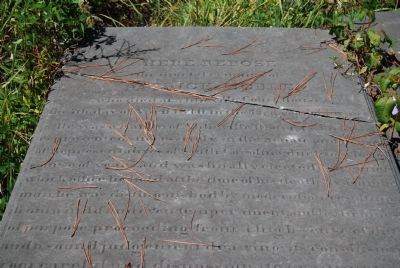
Photographed By Brian Scott, September 13, 2008
14. Gov. Patrick Noble Tombstone
the mortal remains of
Patrick Noble
who died at Abbeville Court House
the 7th day of April 1840 in the 53rd year of his age.
He was a native of Abbeville District which he
represented successively in the Senate and House
of Representative of South Carolina during a long
course of years and was finally elected Governor
which office he held at the time of his death. As a public
man he was distinguished by moderation resulting
from a mild and even temperament and by firmness
of purpose proceeding from a high sense of duty
and sound judgement drawing its conclusions from
careful and dispassionate examination. In all the
relations of private life he was singularly exemplary,
and in public and private, such was the unblemished
purity of his character that both friends and
opponents would concur in inscribing on his tomb,
"Here lie the bones of an honest man." The example
of his virtues silently impressed upon the community
in which he lived, contributed largely to the formation
of the high moral character of his native District
and long will the District, in common with the
whole State deplore his loss.
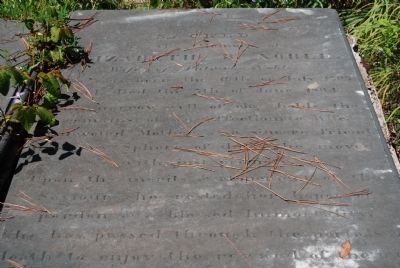
Photographed By Brian Scott, September 13, 2008
15. Elizabeth Noble Tombstone
Elizabeth B. Noble,
wife of Patrick Noble
She was born the 19th of July 1797,
and died the 7th of June 1834.
This narrow cell of clay holds the
remains of an affectionate Wife
and devoted Mother and a sincere friend.
In every Sphere of duty she moved
with just propriety.
Upon the Merits and atonement of the
Saviour she rested her hopes of
pardon, and a blessed Immortality.
She has passed through the portals
of death to enjoy the rewards of the
pure in heart to behold her God.
This stone is erected by her
disconsolate Husband and weeping
children as a memorial of love and
affection for her whose dear memory
will be cherished by them until
they sleep with her in the grave.
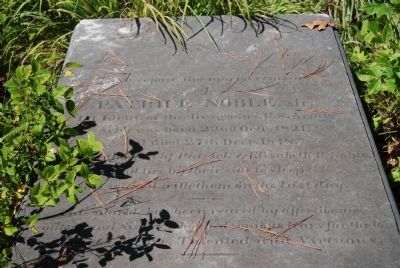
Photographed By Brian Scott, September 13, 2008
16. Patrick Noble Jr. Tombstone
Patrick Noble Jr.
1st Lieut. of the Dragoons, U.S. Army
Who was born 22nd Oct. 1821
and lies by their side to sleep
until waked with them on the last day.
-----*-----
This marble has been erected by affectionate
Brothers, Sisters, who shed copious tears for the
loss of a Brother, Brave, Talented, and Virtuous.
Credits. This page was last revised on December 14, 2019. It was originally submitted on July 20, 2008, by Brian Scott of Anderson, South Carolina. This page has been viewed 4,442 times since then and 96 times this year. Last updated on September 14, 2008, by Brian Scott of Anderson, South Carolina. Photos: 1. submitted on December 8, 2009, by Brian Scott of Anderson, South Carolina. 2. submitted on November 27, 2009, by Brian Scott of Anderson, South Carolina. 3, 4. submitted on July 20, 2008, by Brian Scott of Anderson, South Carolina. 5. submitted on October 23, 2008, by Brian Scott of Anderson, South Carolina. 6. submitted on November 24, 2009, by Brian Scott of Anderson, South Carolina. 7, 8. submitted on November 27, 2009, by Brian Scott of Anderson, South Carolina. 9, 10, 11, 12, 13, 14, 15, 16, 17, 18, 19, 20. submitted on September 14, 2008, by Brian Scott of Anderson, South Carolina. • Kevin W. was the editor who published this page.
